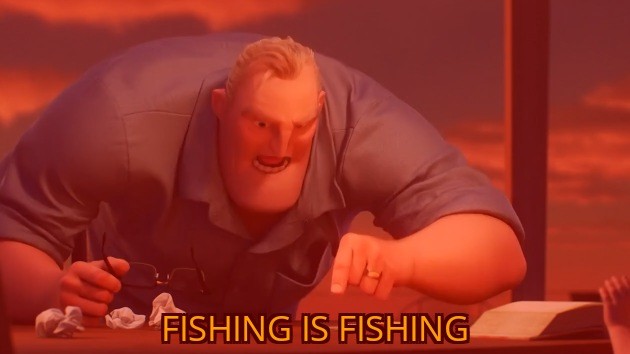My brain is starting to overload
I respect this guy.
Actually, I think you’re wrong, and your numbers are lower then they should be.
You calculate the number of catches during which there is a 50% chance to not not catch a sunken.
The 50% should be fine, it’s all relative anyways, but the other part isn’t: not not catching a sunken doesn’t guarantee only catching one, it also includes the probability of catching 2, or even catching only sunkens, this messes up the later calculations.
My way is as “complicated” as it is because I want to guarantee that my number represents the catches that corelate with catching exactly one sunken. In reality, it’s not complicated at all, it is really intuitive if you’ve ever heard of the Total Probability Formula, which is actually very simple and makes a lot of sense. I would have linked some article that explains it nicely, but they are all too concerned with presenting it very formally, and then give trivial examples that don’t require that much rigour to understand, so I will summarise it myself instead.
Total Probabilty Formula, explained simply for this simple use case
Let there be some event A that you wan’t to calculate the probability of happening, but it could happen as a result of multiple different mutually exclusive events. These events, too, happen with some probability.
Lets say A can happen after event B, with probability pBA, and also after event C with probability pCA. Events B and C are exclusive, and happen with probabilities pB and pC respectively.
The total probability for A happening would then be:
pBpBA + pCpCA
It makes sense, and you can see how it would apply to n cases that could lead to the observed event. I’ll give an example for where it can be used, and then you should see that the same concept of an event happening with a certain probability after another that happens with some other probablity is used in my calculation.
Example
The Little Red Riding Hood needs to go through the woods, and there are 2 possible paths. She chooses a path at random. The wolf roams the woods, and he will eat her if they meet. The probability of the wolf being on path 1 is 1/3, for path 2 it’s 1/4, and the rest of the time he is sleeping somewhere. What is the probability that Red gets eaten?
- A path is chosen at random, so there is probability of 1/2 to go along either path 1 or 2
- The probability of getting eaten on path 1 is 1/3, and on path 2 it’s 1/4
- The total probability of getting eaten when going through the woods is:
1/2 * 1/3 + 1/2 * 1/4 = 7/24
What I did
You should now see where this concept is used in my calculations. It’s not entirely the same, but the idea is similar, the probability of catching a sunken for the first time on some try is the probability of getting that far without catching one multiplied by the probability of catching one in a single try.
If you sum all possible numbers of tries, each multiplied by the probability of catching a sunken on that specific try for the first time, you get the average number of tries required to catch a single sunken.
Nah it’s just the probability at which a sunken won’t occur for x amount of trials, there is no independency because it’s based on the average “.5 or 50%”. It checks where the 99.5% chance will on average stop occurring therefore only being the 50% chance to “not catch a sunken” and if you did not catch a fish or item (combined probability of .995) then you caught a sunken.
Also it’s already tuned to mutually exclusive events.
That’s irrelevant because it’s not checking for that, although it would still be accurate because every non-occurrence of item/fish=sunken
Compute an individual mathematical table if you’d like and you’d get the same result
Basic theorem that everyone who’s seen a coin knows
But actually check your own equation
After accounting for 3 thousand 1554 trials should be roughly 50% of getting a sunken correct? While that would still only give a roughly 46% before accounting and the fact you accounted for 3000 should put you lower that the probability without pity
Do note this could be a problem with C++ because long doubles still have like everything else, double precision point rounding which is why you shouldn’t just use exponents on numbers like these and use natural logarithms.
It could also be due to your cutoff at 3000 because that literally reduces the odds in your equation when you could’ve accounted for them by adding the probability of not getting a sunken for at least 3000 tries onto a natural logarithm like i’d done in the post after.
can we get someone to dumb this down?
Anybody a dumb translator?
just
just bear with it until a clear answer comes out after they peer review another ;-;
I forgor to mention, the best way of getting sunkens is still, not catching fish, if it was catching fish it would be luring bronze

Luring bronze?
Got back to Sturdy wooden.

Skimmed the topic.
In summary, I think that Luring Collector’s or Magnetic Bronze is just best for trying to get Sunken fast with intent, while Luring Bronze would be best if you have a ton of bait and plan on fishing thousands of times.
This
whats your gpa lmao
Gpa has nothing to do with probability, you just search up a probability formula explanation and ez
Bruh why tf did you guys argue and do all that math, it’s just a 0/0 chance to get a sunken on any catch 
Yes, so ln0.5/ln(1 - 1/2000) is the amount of trials x, during which there is a 50% chance to not get a sunken at all, and consequently the other 50% chance to get at least one, and nothing more.
You shouldn’t use it as a number of tries after which you would expect a single sunken.
The rundown of all outcomes for the numbers you get is, very roughly:
| Outcome | Probability |
|---|---|
| No sunkens | 50% |
| Exactly 1 sunken | 33% |
| Exactly 2 sunkens | 9% |
| Exactly 3 sunkens | 1% |
| And so on | And so forth |
Do you see how using this as an average number of tries for which you would get exactly 1 sunken would not give good results? You would need to show specifically that it doesn’t matter, which it does.
I did it the way I did to avoid that whole thing, shoot straight for the average number of catches after which you would get exactly one sunken, get a slightly more complex formula, but hey, we have computers to calculate that stuff.
Exactly, that’s why my way of doing it is actually very intuitive, it’s probably the most straightforward way of computing it.
Yup, that’s why instead of calculating the (1 - 1/x)^(k-1) part on every step, I set it as 1 and multiplied by (1 - 1/x) each iteration.
The code exactly implements the formula, it introduces no meaningful errors.
True, it’s sharking lucky yet gullible children.
But I was interest in finding the best rod for sunken/time.
Meta them started again, please resume this math thing idk
Ya I screwed up the probabilities and used the wrong formula
I concede on the probability front but intuitively speaking, you failed many other fronts.
Luring Bronze rod has a 1/2400 chance of catching sunken as well as recast and reeling accounting for 30%+ of the time
Even using your formula when
Was referring to the method I’m about to reveal actually
Just don’t catch fish, catch only items
This puts luring collector’s at the top by virtue of a very significantly larger sunken chance and the difference in fishing speed being relatively outclassed with collector’s increased odds even accounting for your calculations.
This final conclusion hasn’t changed since the last time I made it with NoBanana because the ~22.3% chance you hit 3000 without sunken doesn’t outweigh the benefits of simply not catching fish.
understanding one line of this post makes me feel so intelligent